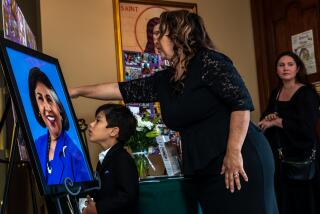What business leaders can learn from Mother Teresa
- Share via
“The rich world has a poor conscience,” wrote Christopher Hitchens in one of his assaults on the reputation of Mother Teresa, “and many people liked to alleviate their own unease by sending money to a woman who seemed like an activist for ‘the poorest of the poor.’”
He has called Mother Teresa a friend of poverty, rather than the poor, and a Roman Catholic fundamentalist. His view is rhetorically harsh, but worth reflecting on as one reads “Mother Teresa, CEO: Unexpected Principles for Practical Leadership,” a paean to the leadership talents of history’s most famous Albanian.
My father spent many years at an Anglican mission in Kolkata, India, doing work similar to that of Mother Teresa’s Missionaries of Charity, and always said admiringly that she was a hard nut, iron-willed and politically adept in a way that one rarely finds in the world of religious charities.
While other efforts to help the poor floundered for lack of funds, Mother Teresa courted publicity for the financial resources it brought her, but almost to the point of immodesty.
She risked her credibility by taking money from former Haitian dictator Jean-Claude “Baby Doc” Duvalier and let herself be trivialized by the many who sought to bask in her reputation as a modern saint.
So what lessons does she provide for the business leader? Authors Ruma Bose, co-chief executive of Sprayology, a “wellness company,” and Lou Faust, a strategic advisor, try to divine some answers from her example in “Mother Teresa, CEO.” It is published by BK Business.
Bose spent time as a volunteer at the Missionaries of Charity in Kolkata, the city formerly known as Calcutta, some 20 years ago. The experience, she writes, shaped her as a businesswoman, guiding her through the vicissitudes of running a janitorial services business and now at Sprayology.
She and Faust lay out eight “Teresa principles”: “dream it simple, say it strong”; “to get to the angels, deal with the devil; wait, then pick your moment”; “embrace the power of doubt”; “discover the joy of discipline”; “communicate in a language people understand”; “pay attention to the janitor”; “use the power of silence.”
The first step to leading like Mother Teresa is to decide “What are you Mother Teresa of?” What is the vision you are capable of bringing to reality? “Dealing with devils to get to the angels” is the authors’ way of excusing her taking Duvalier’s money.
The cause was right, even if the source of the money was tainted. They suggest Mother Teresa had an ethical framework that allowed her to make such decisions, and that we should do the same.
Likewise, we should develop a framework for dealing with doubt, as successful leaders “find courage in the face of fear so that they can lead their organizations forward.”
The authors dare not say it, but obviously Mother Teresa’s framework was her Christian faith, beliefs that would never make it into an executive management diagram.
Mother Teresa also possessed what Peter Drucker called the “bias toward action.” Bose and Faust say she believed that “if something needs washing, wash it. If something needs fixing, fix it.”
There are moments in the book when you realize how vast the gulf is between business writing and normality. Bose compares Mother Teresa’s devotion to discipline to her own commitment to jogging. And Faust recommends keeping a book of office malapropisms to generate the kind of joy in work shown by Mother Teresa’s nuns.
Other tips are worth being reminded of, such as the importance of good manners and taking time to think rather than endlessly acting.
The book’s greatest merit may be its brevity. Unlike many business books, it does not gas on for 200 pages more than it should. But to get a real sense of the joys and travails of Mother Teresa as CEO, I recommend her private writings, which show how lonely it was at the top.
Philip Delves Broughton is a columnist for the Financial Times of London, in which this review first appeared, and is the author of “Ahead of the Curve: Two Years at Harvard Business School.”
More to Read
Inside the business of entertainment
The Wide Shot brings you news, analysis and insights on everything from streaming wars to production — and what it all means for the future.
You may occasionally receive promotional content from the Los Angeles Times.









